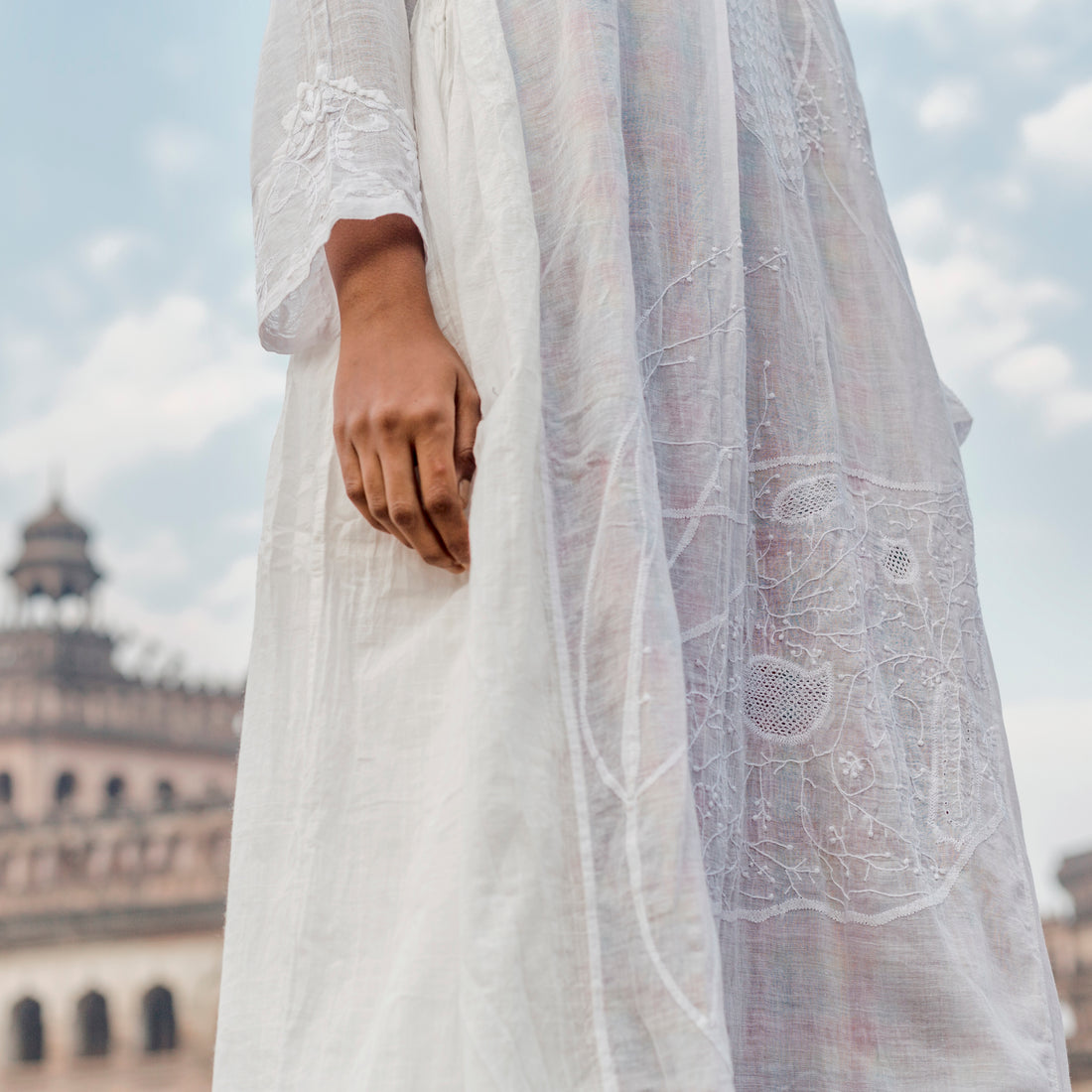
Music of Muslin
Injiri celebrates the quiet beauty of jamdani and chikankari
Guest edited by Chinar Farooqui of Injiri
Whether brocade woven, embroidered, or unadorned, muslin has enticed everyone interested in handmade, artisanal excellence and history.
Originally from Dhaka, Bangladesh (then India), this famous and fascinating fabric, muslin, was once no less than a treasure. Known worldwide for its fine texture and easy fall, muslin was loved for its supple, flowing quality. It is woven using the plain weave structure, in which a single weft thread alternates over and under a single warp thread. Muslin fabric was often referred to locally as Baft Hawa, woven air, and Abrawan, flowing water.

Chikankari probably originated in Calcutta and Dacca among Bengali embroiderers, perhaps as an alternative to jamdani; sometimes, the designs are almost indistinguishable. Both chikankari and jamdani are shadow-work, done white on white. This art form enjoyed patronage from the Mughals, under whom muslin, jamdani, and chikankari reached unprecedented standards of excellence.
Injiri, the brand launched by Chinar Farooqui in 2009, has collaborated with the jamdani weavers for the past 14 years. Farooqui's 2010 visit to Ghoranash, in West Bengal, marked the initial phase of developing yardage. This technique is primarily used for sarees where its loose structure is an asset. When Farooqui started working with jamdani, it was a challenge to construct garments from such fine cloth, so she spent three years collaborating with the weavers to develop a more tightly structured, stronger cloth that could withstand the rigour of stitched garments without compromising on its weight and handle. The weavers found the task challenging but eventually triumphed. Initially, the designs were limited to simple borders; however, they have since progressed to integrating more intricate and labour-intensive patterns into the work.
In 2015, Injiri embarked on a journey to explore the chikankari embroidery technique, confronting a significant challenge: translating traditional motifs into contemporary design. A notable issue was the considerable reduction in the variety and quality of stitches commonly practised, which the embroiderers attributed to the demands of the mass market, which Farooqui identified as the primary obstacle. Her inspiration stemmed from the exquisite chikankari found in 19th-century angarkhas (outer robe with long sleeves), chogas (a loose-fitted, long-sleeved robe with an open front), and jamas (a side-fastening frock-coat with tight-fitting bodice, nipped-in waist and flared skirt, reaching the knees.); she had studied at the Calico Museum of Textiles, Ahmedabad, and the Victoria and Albert Museum, London. It required considerable time and effort to discover a method of employing this technique that resonated with the brand's aesthetic vision of beauty.

From 2010 to 2020, she produced 20,000 metres of jamdani fabric annually within the jamdani weaving community and 3,000 metres of chikankari hand-embroidered textiles in Lucknow annually for the Injiri women’s wear garments.
Her Music of Muslin is a project developed during the COVID pandemic, as weavers and embroiderers faced unprecedented challenges and sought employment opportunities. Farooqui was inspired to commission show pieces that would celebrate their artistry at the highest level. “It inspires the artist in me to see the craft in its zenith,” she says. “A world lost now but something I always look at for inspiration. I commissioned these panels to recreate the world of beauty that I think is absolute. The project talks about today’s weavers and embroidery skill set.”
Farooqui is continuously inspired by the delicacy of these finely handwoven textiles. The exquisite tonality of white on white, the interplay between light and shadow, makes a white handwoven textile a true connoisseur’s choice. The work incorporating jamdani and chikankari is inspired by how white as a colour can be used to create an ethereal beauty, simplicity, and texture. Farooqui’s project thus attempts to explore the higher realm of artistry these craft clusters hold, which is impossible to do commercially.
This project focuses on the highest point of the two crafts, which are dedicated to the weight and flowing versatility of Indian muslin and celebrate its quiet beauty. The panels serve as a reminder of the intangible human heritage passed down through countless generations of patrons and artists. The Mughals were ardent supporters of jamdani, and under their leadership, this fine art reached previously unheard-of heights. The Mehrab motif, common in Islamic art and architecture during the Mughal era, is featured on these panels.

While the chikankari panels are examples of Mughal-era shadow embroidery done in white on white, they are unique in themselves because of the intricate jaals, or mesh-like structures, and dense compositions of Mughal floral patterns that also frequently include entwined floral creepers and intricately embroidered paisley motifs known as keiri, tiny buds, tendrils, and frequent use of paan leaves – a status symbol in Lucknow.
The clothing in the Music of Muslin collection pays homage to this craft technique and royal costumes. With the Lucknow embroidery and Jamdani’s supplementary weft inlay technique, which allows for the play of forms on backgrounds of solid colour, the motifs used in the clothing are both modern and deeply rooted in tradition. To cut a garment with the least amount of waste possible, Injiri adopted a conservative silhouette strategy.

What entices Farooqui the most is the combination of spontaneity and classicism in traditional textiles. Going deeper into the design and the social aspect of locally made materials in India, she has discovered the meaning of this textile heritage, drawing from the aesthetics and the various textile elements intrinsic to the communal, environmental, and cultural structure. Due to skill exchanges, weaving skills and traditions have been perpetuated in the context of weavers’ cultures. In the current weaving cultural milieu, traditional handwoven textiles are symbolically expressed. Thus, the material and fabric have much to say about how they’re made.
Guest edited by Chinar Farooqui of Injiri
Whether brocade woven, embroidered, or unadorned, muslin has enticed everyone interested in handmade, artisanal excellence and history.
Originally from Dhaka, Bangladesh (then India), this famous and fascinating fabric, muslin, was once no less than a treasure. Known worldwide for its fine texture and easy fall, muslin was loved for its supple, flowing quality. It is woven using the plain weave structure, in which a single weft thread alternates over and under a single warp thread. Muslin fabric was often referred to locally as Baft Hawa, woven air, and Abrawan, flowing water.

Chikankari probably originated in Calcutta and Dacca among Bengali embroiderers, perhaps as an alternative to jamdani; sometimes, the designs are almost indistinguishable. Both chikankari and jamdani are shadow-work, done white on white. This art form enjoyed patronage from the Mughals, under whom muslin, jamdani, and chikankari reached unprecedented standards of excellence.
Injiri, the brand launched by Chinar Farooqui in 2009, has collaborated with the jamdani weavers for the past 14 years. Farooqui's 2010 visit to Ghoranash, in West Bengal, marked the initial phase of developing yardage. This technique is primarily used for sarees where its loose structure is an asset. When Farooqui started working with jamdani, it was a challenge to construct garments from such fine cloth, so she spent three years collaborating with the weavers to develop a more tightly structured, stronger cloth that could withstand the rigour of stitched garments without compromising on its weight and handle. The weavers found the task challenging but eventually triumphed. Initially, the designs were limited to simple borders; however, they have since progressed to integrating more intricate and labour-intensive patterns into the work.
In 2015, Injiri embarked on a journey to explore the chikankari embroidery technique, confronting a significant challenge: translating traditional motifs into contemporary design. A notable issue was the considerable reduction in the variety and quality of stitches commonly practised, which the embroiderers attributed to the demands of the mass market, which Farooqui identified as the primary obstacle. Her inspiration stemmed from the exquisite chikankari found in 19th-century angarkhas (outer robe with long sleeves), chogas (a loose-fitted, long-sleeved robe with an open front), and jamas (a side-fastening frock-coat with tight-fitting bodice, nipped-in waist and flared skirt, reaching the knees.); she had studied at the Calico Museum of Textiles, Ahmedabad, and the Victoria and Albert Museum, London. It required considerable time and effort to discover a method of employing this technique that resonated with the brand's aesthetic vision of beauty.

From 2010 to 2020, she produced 20,000 metres of jamdani fabric annually within the jamdani weaving community and 3,000 metres of chikankari hand-embroidered textiles in Lucknow annually for the Injiri women’s wear garments.
Her Music of Muslin is a project developed during the COVID pandemic, as weavers and embroiderers faced unprecedented challenges and sought employment opportunities. Farooqui was inspired to commission show pieces that would celebrate their artistry at the highest level. “It inspires the artist in me to see the craft in its zenith,” she says. “A world lost now but something I always look at for inspiration. I commissioned these panels to recreate the world of beauty that I think is absolute. The project talks about today’s weavers and embroidery skill set.”
Farooqui is continuously inspired by the delicacy of these finely handwoven textiles. The exquisite tonality of white on white, the interplay between light and shadow, makes a white handwoven textile a true connoisseur’s choice. The work incorporating jamdani and chikankari is inspired by how white as a colour can be used to create an ethereal beauty, simplicity, and texture. Farooqui’s project thus attempts to explore the higher realm of artistry these craft clusters hold, which is impossible to do commercially.
This project focuses on the highest point of the two crafts, which are dedicated to the weight and flowing versatility of Indian muslin and celebrate its quiet beauty. The panels serve as a reminder of the intangible human heritage passed down through countless generations of patrons and artists. The Mughals were ardent supporters of jamdani, and under their leadership, this fine art reached previously unheard-of heights. The Mehrab motif, common in Islamic art and architecture during the Mughal era, is featured on these panels.

While the chikankari panels are examples of Mughal-era shadow embroidery done in white on white, they are unique in themselves because of the intricate jaals, or mesh-like structures, and dense compositions of Mughal floral patterns that also frequently include entwined floral creepers and intricately embroidered paisley motifs known as keiri, tiny buds, tendrils, and frequent use of paan leaves – a status symbol in Lucknow.
The clothing in the Music of Muslin collection pays homage to this craft technique and royal costumes. With the Lucknow embroidery and Jamdani’s supplementary weft inlay technique, which allows for the play of forms on backgrounds of solid colour, the motifs used in the clothing are both modern and deeply rooted in tradition. To cut a garment with the least amount of waste possible, Injiri adopted a conservative silhouette strategy.

What entices Farooqui the most is the combination of spontaneity and classicism in traditional textiles. Going deeper into the design and the social aspect of locally made materials in India, she has discovered the meaning of this textile heritage, drawing from the aesthetics and the various textile elements intrinsic to the communal, environmental, and cultural structure. Due to skill exchanges, weaving skills and traditions have been perpetuated in the context of weavers’ cultures. In the current weaving cultural milieu, traditional handwoven textiles are symbolically expressed. Thus, the material and fabric have much to say about how they’re made.
